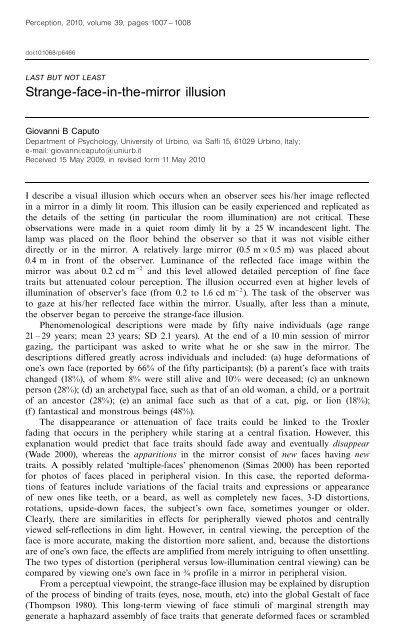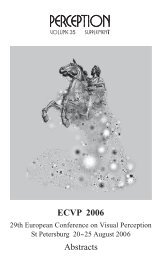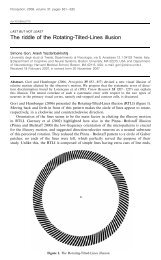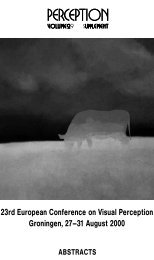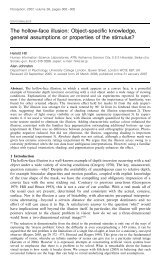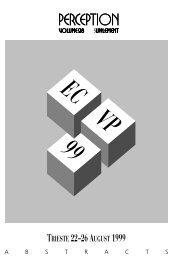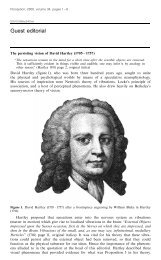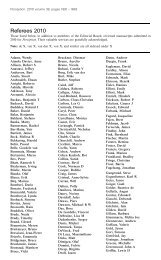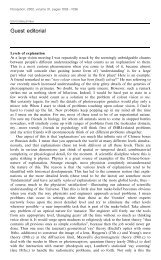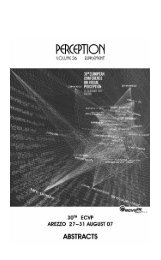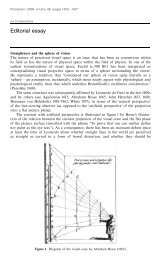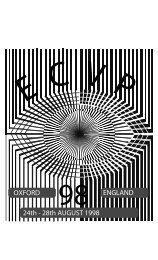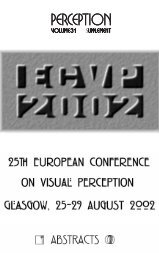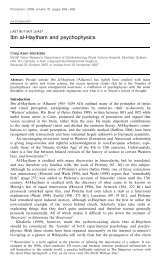Strange-face-in-the-mirror illusion - Perception
Strange-face-in-the-mirror illusion - Perception
Strange-face-in-the-mirror illusion - Perception
Create successful ePaper yourself
Turn your PDF publications into a flip-book with our unique Google optimized e-Paper software.
<strong>Perception</strong>, 2010, volume 39, pages 1007 ^ 1008<br />
doi:10.1068/p6466<br />
LAST BUT NOT LEAST<br />
<strong>Strange</strong>-<strong>face</strong>-<strong>in</strong>-<strong>the</strong>-<strong>mirror</strong> <strong>illusion</strong><br />
Giovanni B Caputo<br />
Department of Psychology, University of Urb<strong>in</strong>o, via Saffi 15, 61029 Urb<strong>in</strong>o, Italy;<br />
e-mail: giovanni.caputo@uniurb.it<br />
Received 15 May 2009, <strong>in</strong> revised form 11 May 2010<br />
I describe a visual <strong>illusion</strong> which occurs when an observer sees his/her image reflected<br />
<strong>in</strong> a <strong>mirror</strong> <strong>in</strong> a dimly lit room. This <strong>illusion</strong> can be easily experienced and replicated as<br />
<strong>the</strong> details of <strong>the</strong> sett<strong>in</strong>g (<strong>in</strong> particular <strong>the</strong> room illum<strong>in</strong>ation) are not critical. These<br />
observations were made <strong>in</strong> a quiet room dimly lit by a 25 W <strong>in</strong>candescent light. The<br />
lamp was placed on <strong>the</strong> floor beh<strong>in</strong>d <strong>the</strong> observer so that it was not visible ei<strong>the</strong>r<br />
directly or <strong>in</strong> <strong>the</strong> <strong>mirror</strong>. A relatively large <strong>mirror</strong> (0.5 m60.5 m) was placed about<br />
0.4 m <strong>in</strong> front of <strong>the</strong> observer. Lum<strong>in</strong>ance of <strong>the</strong> reflected <strong>face</strong> image with<strong>in</strong> <strong>the</strong><br />
<strong>mirror</strong> was about 0.2 cd m 2 and this level allowed detailed perception of f<strong>in</strong>e <strong>face</strong><br />
traits but attenuated colour perception. The <strong>illusion</strong> occurred even at higher levels of<br />
illum<strong>in</strong>ation of observer's <strong>face</strong> (from 0.2 to 1.6 cd m 2 ). The task of <strong>the</strong> observer was<br />
to gaze at his/her reflected <strong>face</strong> with<strong>in</strong> <strong>the</strong> <strong>mirror</strong>. Usually, after less than a m<strong>in</strong>ute,<br />
<strong>the</strong> observer began to perceive <strong>the</strong> strange-<strong>face</strong> <strong>illusion</strong>.<br />
Phenomenological descriptions were made by fifty naive <strong>in</strong>dividuals (age range<br />
21 ^ 29 years; mean 23 years; SD 2.1 years). At <strong>the</strong> end of a 10 m<strong>in</strong> session of <strong>mirror</strong><br />
gaz<strong>in</strong>g, <strong>the</strong> participant was asked to write what he or she saw <strong>in</strong> <strong>the</strong> <strong>mirror</strong>. The<br />
descriptions differed greatly across <strong>in</strong>dividuals and <strong>in</strong>cluded: (a) huge deformations of<br />
one's own <strong>face</strong> (reported by 66% of <strong>the</strong> fifty participants); (b) a parent's <strong>face</strong> with traits<br />
changed (18%), of whom 8% were still alive and 10% were deceased; (c) an unknown<br />
person (28%); (d) an archetypal <strong>face</strong>, such as that of an old woman, a child, or a portrait<br />
of an ancestor (28%); (e) an animal <strong>face</strong> such as that of a cat, pig, or lion (18%);<br />
(f) fantastical and monstrous be<strong>in</strong>gs (48%).<br />
The disappearance or attenuation of <strong>face</strong> traits could be l<strong>in</strong>ked to <strong>the</strong> Troxler<br />
fad<strong>in</strong>g that occurs <strong>in</strong> <strong>the</strong> periphery while star<strong>in</strong>g at a central fixation. However, this<br />
explanation would predict that <strong>face</strong> traits should fade away and eventually disappear<br />
(Wade 2000), whereas <strong>the</strong> apparitions <strong>in</strong> <strong>the</strong> <strong>mirror</strong> consist of new <strong>face</strong>s hav<strong>in</strong>g new<br />
traits. A possibly related `multiple-<strong>face</strong>s' phenomenon (Simas 2000) has been reported<br />
for photos of <strong>face</strong>s placed <strong>in</strong> peripheral vision. In this case, <strong>the</strong> reported deformations<br />
of features <strong>in</strong>clude variations of <strong>the</strong> facial traits and expressions or appearance<br />
of new ones like teeth, or a beard, as well as completely new <strong>face</strong>s, 3-D distortions,<br />
rotations, upside-down <strong>face</strong>s, <strong>the</strong> subject's own <strong>face</strong>, sometimes younger or older.<br />
Clearly, <strong>the</strong>re are similarities <strong>in</strong> effects for peripherally viewed photos and centrally<br />
viewed self-reflections <strong>in</strong> dim light. However, <strong>in</strong> central view<strong>in</strong>g, <strong>the</strong> perception of <strong>the</strong><br />
<strong>face</strong> is more accurate, mak<strong>in</strong>g <strong>the</strong> distortion more salient, and, because <strong>the</strong> distortions<br />
are of one's own <strong>face</strong>, <strong>the</strong> effects are amplified from merely <strong>in</strong>trigu<strong>in</strong>g to often unsettl<strong>in</strong>g.<br />
The two types of distortion (peripheral versus low-illum<strong>in</strong>ation central view<strong>in</strong>g) can be<br />
compared by view<strong>in</strong>g one's own <strong>face</strong> <strong>in</strong> ÅÙ Æ profile <strong>in</strong> a <strong>mirror</strong> <strong>in</strong> peripheral vision.<br />
From a perceptual viewpo<strong>in</strong>t, <strong>the</strong> strange-<strong>face</strong> <strong>illusion</strong> may be expla<strong>in</strong>ed by disruption<br />
of <strong>the</strong> process of b<strong>in</strong>d<strong>in</strong>g of traits (eyes, nose, mouth, etc) <strong>in</strong>to <strong>the</strong> global Gestalt of <strong>face</strong><br />
(Thompson 1980). This long-term view<strong>in</strong>g of <strong>face</strong> stimuli of marg<strong>in</strong>al strength may<br />
generate a haphazard assembly of <strong>face</strong> traits that generate deformed <strong>face</strong>s or scrambled
1008 Last but not least<br />
<strong>face</strong>s. Frequent apparitions of strange <strong>face</strong>s of known or unknown people support <strong>the</strong><br />
idea that <strong>the</strong> <strong>illusion</strong> <strong>in</strong>volves a high-level mechanism that is specific to global <strong>face</strong><br />
process<strong>in</strong>g. On <strong>the</strong> o<strong>the</strong>r hand, <strong>the</strong> frequent apparition of fantastical and monstrous<br />
be<strong>in</strong>gs, and of animal <strong>face</strong>s cannot, <strong>in</strong> our op<strong>in</strong>ion, be expla<strong>in</strong>ed by any actual <strong>the</strong>ory<br />
of <strong>face</strong> process<strong>in</strong>g. Nei<strong>the</strong>r constructive approaches nor top ^ down accounts seem to<br />
provide adequate explanations.<br />
The participants reported that apparition of new <strong>face</strong>s <strong>in</strong> <strong>the</strong> <strong>mirror</strong> caused sensations<br />
of o<strong>the</strong>rness when <strong>the</strong> new <strong>face</strong> appeared to be that of ano<strong>the</strong>r, unknown person<br />
or strange `o<strong>the</strong>r' look<strong>in</strong>g at him/her from with<strong>in</strong> or beyond <strong>the</strong> <strong>mirror</strong>. All fifty participants<br />
experienced some form of this dissociative identity effect, at least for some<br />
apparition of strange <strong>face</strong>s and often reported strong emotional responses <strong>in</strong> <strong>the</strong>se<br />
<strong>in</strong>stances. For example, some observers felt that <strong>the</strong> `o<strong>the</strong>r' watched <strong>the</strong>m with an<br />
enigmatic expressionöa situation that <strong>the</strong>y found astonish<strong>in</strong>g. Some participants saw<br />
a malign expression on <strong>the</strong> `o<strong>the</strong>r' <strong>face</strong> and became anxious. O<strong>the</strong>r participants felt<br />
that <strong>the</strong> `o<strong>the</strong>r' was smil<strong>in</strong>g or cheerful, and experienced positive emotions <strong>in</strong> response.<br />
The apparition of deceased parents or of archetypal portraits produced feel<strong>in</strong>gs of silent<br />
query. Apparition of monstrous be<strong>in</strong>gs produced fear or disturbance. Dynamic deformations<br />
of new <strong>face</strong>s (like pulsations or shr<strong>in</strong>k<strong>in</strong>g, smil<strong>in</strong>g or gr<strong>in</strong>d<strong>in</strong>g) produced an overall<br />
sense of <strong>in</strong>quietude for th<strong>in</strong>gs out of control.<br />
Static <strong>face</strong> pictures and <strong>the</strong> distortions seen when <strong>the</strong>y are peripherally viewed (Simas<br />
2000) <strong>in</strong>volve <strong>the</strong> b<strong>in</strong>d<strong>in</strong>g of <strong>face</strong> traits. In contrast, self-perception <strong>in</strong> a <strong>mirror</strong> engages<br />
a far broader set of processes as <strong>the</strong> image duplicates one's own <strong>face</strong> perfectly <strong>in</strong> space<br />
and time, trigger<strong>in</strong>g an <strong>in</strong>tegration of perceptual, motor, and proprioceptive processes.<br />
It is a dynamic process <strong>in</strong>volv<strong>in</strong>g self-motion and autonomous self-exploratory control<br />
of facial pose and expression (Rochat 2002). The construction of our self-identity<br />
<strong>in</strong>cludes, among o<strong>the</strong>r processes, <strong>the</strong> capacity to recognise oneself <strong>in</strong> <strong>the</strong> <strong>mirror</strong>, a<br />
competence acquired <strong>in</strong> childhood between 2 ^ 3 years of age (Zazzo 1981). Ano<strong>the</strong>r<br />
aspect of <strong>the</strong> strange-<strong>face</strong> <strong>illusion</strong> is <strong>the</strong> potential breakdown of self-identity that may<br />
take place when gaz<strong>in</strong>g at a strange new <strong>face</strong> that has replaced one's own <strong>in</strong> <strong>the</strong> <strong>mirror</strong><br />
for a relatively long time.<br />
Acknowledgment. I would like to greatly thank Patrick Cavanagh for his help <strong>in</strong> revision, advice,<br />
and enthusiastic support.<br />
References<br />
Rochat P, 2002 ``Ego function of early imitation'', <strong>in</strong> The Imitative M<strong>in</strong>d Eds A N Meltzoff, W Pr<strong>in</strong>z<br />
(Cambridge: Cambridge University Press) pp 85 ^ 97<br />
Simas M L, 2000 ``The multiple-<strong>face</strong>s phenomenon: some <strong>in</strong>vestigative studies'' <strong>Perception</strong> 29<br />
1393 ^ 1395<br />
Thompson P, 1980 ``Margaret Thatcher: a new <strong>illusion</strong>'' <strong>Perception</strong> 9 483 ^ 484<br />
Wade N J, 2000 A Natural History of Vision (Cambridge, MA: MIT Press)<br />
Zazzo R, 1981 ``Miroir, images, espaces'', <strong>in</strong> La Reconnaissance de son Image chez l'Enfant et l'Animal<br />
Eds P Mounoud, A V<strong>in</strong>ter (Paris: Delachaux et Niestle¨ )pp77^110<br />
ß 2010 a Pion publication


